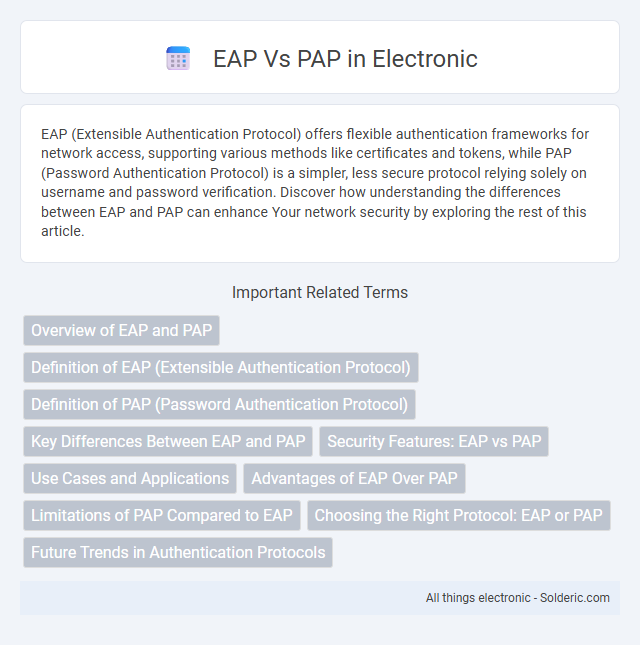EAP (Extensible Authentication Protocol) offers flexible authentication frameworks for network access, supporting various methods like certificates and tokens, while PAP (Password Authentication Protocol) is a simpler, less secure protocol relying solely on username and password verification. Discover how understanding the differences between EAP and PAP can enhance Your network security by exploring the rest of this article.
Comparison Table
| Feature | EAP (Extensible Authentication Protocol) | PAP (Password Authentication Protocol) |
|---|---|---|
| Authentication Type | Flexible, supports multiple methods (e.g., certificates, tokens) | Simple password-based authentication |
| Security | Secure, supports encryption and challenge-response | Insecure, sends passwords in clear text |
| Use Case | Wireless networks, VPNs, enterprise authentication | Legacy systems, simple PPP connections |
| Complexity | Complex, requires backend infrastructure | Simple, minimal setup |
| Supported Protocols | 802.1X, RADIUS, WPA/WPA2 Enterprise | PPP (Point-to-Point Protocol) |
Overview of EAP and PAP
Extensible Authentication Protocol (EAP) is a flexible authentication framework commonly used in wireless networks and point-to-point connections, supporting multiple authentication methods like token cards, certificates, and public key encryption. Password Authentication Protocol (PAP) is a simpler, less secure authentication protocol that transmits user credentials in plaintext for verification in PPP (Point-to-Point Protocol) connections. EAP offers enhanced security features and extensibility, making it suitable for modern network environments compared to the basic and less secure PAP.
Definition of EAP (Extensible Authentication Protocol)
EAP (Extensible Authentication Protocol) is an authentication framework used in network access and communication protocols, supporting multiple authentication methods such as token cards, certificates, and public key encryption. Unlike PAP (Password Authentication Protocol), which transmits passwords in plain text, EAP provides a flexible structure for secure and encrypted authentication exchanges. EAP is widely employed in wireless networks and point-to-point connections to enhance security through its extensibility and support for complex authentication mechanisms.
Definition of PAP (Password Authentication Protocol)
Password Authentication Protocol (PAP) is a simple, plaintext authentication mechanism used in Point-to-Point Protocol (PPP) connections, transmitting user credentials without encryption. Unlike Extensible Authentication Protocol (EAP), PAP provides minimal security and is vulnerable to interception and replay attacks. You should consider stronger alternatives for environments requiring enhanced protection of authentication data.
Key Differences Between EAP and PAP
EAP (Extensible Authentication Protocol) supports multiple authentication methods and provides flexible, secure frameworks for network access, whereas PAP (Password Authentication Protocol) uses a simple, unencrypted username and password exchange, making it less secure. EAP is widely used in wireless networks and VPNs due to its support for strong encryption and mutual authentication, while PAP is typically employed in older, less secure systems. Your choice between EAP and PAP should consider security needs, with EAP offering robust protection against eavesdropping and replay attacks.
Security Features: EAP vs PAP
EAP (Extensible Authentication Protocol) provides robust security features by supporting multiple authentication methods, including certificate-based, token-based, and encrypted credential exchanges, making it highly resistant to eavesdropping and replay attacks. PAP (Password Authentication Protocol) transmits passwords in plaintext without encryption, making it vulnerable to interception and unauthorized access. EAP's flexible framework enhances network security by enabling strong mutual authentication and integrity checks, whereas PAP lacks these essential protections.
Use Cases and Applications
EAP (Extensible Authentication Protocol) supports diverse authentication methods ideal for complex network environments such as enterprise Wi-Fi, VPNs, and mobile networks demanding strong security and flexibility. PAP (Password Authentication Protocol) is suited for simple use cases with minimal security requirements, often deployed in legacy systems or basic point-to-point connections where ease of implementation takes precedence over security. Your choice between EAP and PAP depends on the security level needed and the specific network application, with EAP favored for robust, scalable authentication frameworks.
Advantages of EAP Over PAP
EAP offers enhanced security features compared to PAP by supporting mutual authentication and dynamic encryption, significantly reducing the risk of credential theft. You benefit from more flexible authentication methods, including token-based and certificate-based mechanisms, which improve overall network security. EAP's extensible framework allows seamless integration with modern security protocols, making it a more robust choice for protecting sensitive data in wireless and remote access networks.
Limitations of PAP Compared to EAP
PAP (Password Authentication Protocol) lacks encryption, transmitting passwords in clear text, which makes it vulnerable to interception and replay attacks, unlike EAP (Extensible Authentication Protocol) that supports multiple secure authentication methods with encryption. PAP's simplicity limits it to basic username and password verification without support for mutual authentication, whereas EAP allows dynamic, robust authentication mechanisms accommodating certificates, tokens, and biometrics. The rigid design of PAP restricts its application in modern secure network environments, where EAP's flexibility and security protocols are essential for protecting sensitive data.
Choosing the Right Protocol: EAP or PAP
Choosing the right protocol between EAP (Extensible Authentication Protocol) and PAP (Password Authentication Protocol) depends on your security needs and network environment. EAP offers stronger security through support for various authentication methods like certificates and token cards, making it ideal for enterprise-level and wireless networks. PAP, being simpler and less secure, may suffice for legacy systems or low-risk applications but exposes your credentials to potential interception.
Future Trends in Authentication Protocols
Future trends in authentication protocols highlight the growing adoption of EAP (Extensible Authentication Protocol) over PAP (Password Authentication Protocol) due to EAP's enhanced flexibility and security features, including support for multi-factor authentication and certificate-based credentials. EAP's ability to integrate with modern identity frameworks and adapt to evolving threats positions it as the preferable choice in enterprise and IoT environments. Your network's security posture will benefit significantly from transitioning to EAP to accommodate advancements in zero-trust security models and biometric authentication methods.
EAP vs PAP Infographic

 solderic.com
solderic.com